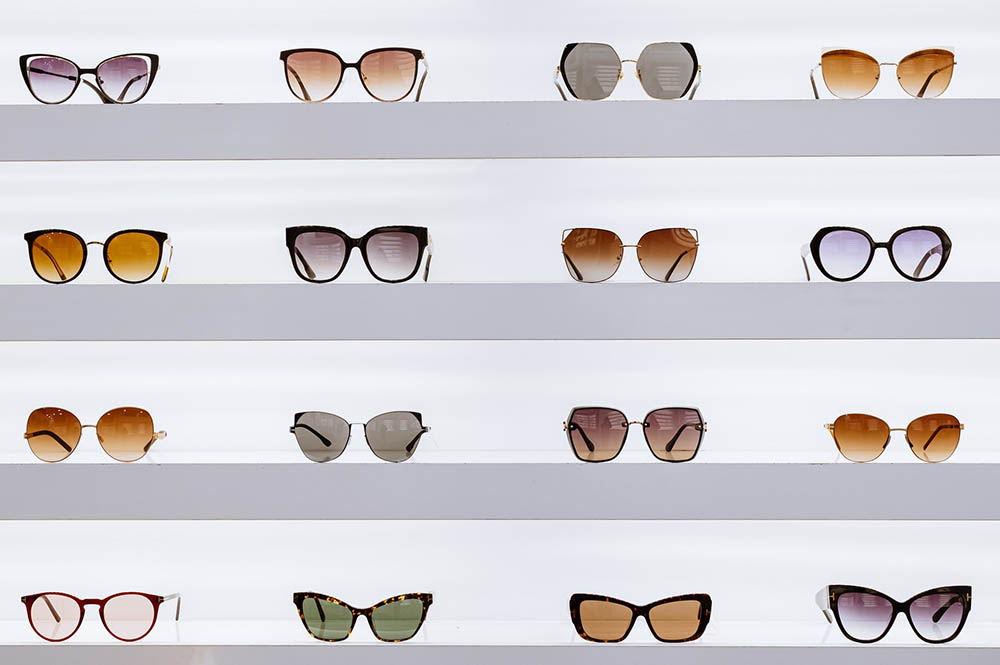When Were Sunglasses Invented? The History of Sunglasses
Last Updated on

Sunglasses, as we know them today, first appeared in 1899 when Rodenstock, a German company, produced the first spectacles with UV protection lenses.
But the idea of wearing some form of goggles to protect the eyes against the sun’s glare can be traced back to prehistoric times. In fact, like most innovations, sunglasses have developed over the centuries into what they are today.
If you’d like to learn more about the fascinating history of sunglasses, get ready to don your rose-tinted goggles as we look back through time at their evolution.

Prehistory – Ivory Sunglasses
Humans have used various methods of creating visors to shade their eyes from the sun’s glare, but the Inuits had to come up with a way to protect themselves from snow blindness—also called photokeratitis. The sun’s harsh rays reflect off snowy and icy surfaces, increasing the amount of ultraviolet that enters the eyes. It effectively causes the cornea, the transparent layer that covers the eye, to get sunburnt.
To solve this problem, the Inuits carved flattened caribou antlers, walrus ivory, driftwood, and other materials, into tightly fitting snow goggles, with only two narrow slits running horizontally across either side where each eye would be. This ingenious invention significantly reduced the amount of sunlight that entered the eyes and might have even improved vision by focusing the light in one direction.
Whilst these snow goggles were a far cry from the ones Tom Cruise and Val Kilmer sported in the 1986 blockbuster, Top Gun, they were highly effective in reducing the chance of snow blindness.
12th Century – Smoky Quartz Lenses
In the 12th Century, or possibly earlier, eyeglasses with smoky quartz lenses were created in China. These spectacles did nothing to improve or correct vision, but they did help to reduce the sun’s glare.
It is unclear whether these sunglasses were invented with the purpose of correcting vision, however. Historic documents describe how the smoky quartz, or Ai Tai, glasses were worn by judges, in order to conceal their facial expressions during trials.
18th Century – Blue and Green Tinted Lenses
English optician and scientific instrument maker, James Ayscough, made and recommended spectacles with blue or green-tinted lenses to treat certain vision impairments.
In a 1772 illustration by Madame Lavoisier, scientist Antoine Lavoisier is depicted wearing sunglasses to protect his eyes during an experiment in amplifying sunlight through lenses.
19th Century – Yellow and Brown Tinted Lenses

By the 19th century, tinted glasses gained moderate popularity amongst those who could afford them. Amber and brown-tinted glasses were prescribed to those who suffered from syphilis, of which one of the symptoms is sensitivity to light.
Although these glasses with their green, blue, and amber-tinted lenses may look great to us, they do not protect their wearers against the harmful effects of ultraviolet rays.
19th century French physician and ophthalmologist Théodore-Édouard Fieuzal was reportedly the first to argue for UV protection, but it wasn’t until 1899 that the first ultraviolet blocking lens glasses were produced by Rodenstock.
20th Century – Cerium Sunglasses

It was during the 20th century that sunglasses exploded into popular culture.
It began in 1913. Chemist and physicist William Crookes had carried out over 300 numbered and labeled formulations in his effort to create a lens glass that would protect glass workers against cataracts. The unintended results were the invention of a range of lenses with different uses, including the cerium infused lens, which blocked 100% of ultraviolet and 90% infrared.
Movie stars, as the influencers of their time, began wearing sunglasses in the early 1920s.
While it may have begun as a convenient way to disguise their famous countenance, it soon became a symbol of glamour.
Naturally, the demand for sunglasses exploded, and in 1929, affordable celluloid sunglasses were mass-produced.
Pop Culture
An article from Life magazine issue dated May 30th, 1938 stated that sunglasses were a “new fad for wear on city streets…a favorite affection of thousands of women all over the U.S.” The article goes on to state that 20 million sunglasses were sold in the U.S. in 1937.
But it wasn’t just the movie and fashion industry that propelled the popularity of sunglasses.
Aviator Sunglasses
In the 1930’s Edwin H. Land began experimenting with his patented Polaroid filter to create polarized lenses. These lenses block the intense light that reflects off bright surfaces such as water, sand, and snow. The polarized sunglasses became available in 1936.
American company Bausch and Lomb later went on to create their own polarized sunglasses. Using polarized lenses to deflect glare, these sunglasses were used by U.S. Air Force pilots, as a sleek and modern replacement for their old gear.
During the Second World War, a widely spread photograph of General Douglas MacArthur wearing Bausch and Lomb these sunglasses contributed to the fame of and popularity of the aviator “Ray-Bans”, which were soon to be worn by icons such as Elvis Presley, Michael Jackson, and of course, by Tom Cruise and Val Kilmer.

Today – Back to the Present
From astronauts to pilots, to catwalk models and everybody in between, sunglasses have become an everyday, easy-to-obtain item that’s not only fashionable but sight-saving.
For people who rely on sunglasses because of their location, their profession, or even those who play sports and spend a lot of time outdoors, it is important to ensure that the sunglasses they opt to use meet the correct standards for eye protection. In the U.S., these guidelines are set by the American National Standards Institute.

In Conclusion
As for fashion statements, sunglasses can be found in a variety of styles, colors, and shapes. In the year 2012, Chopard famously showcased a pair of diamond-studded sunglasses worth $400,000. On the other end of the spectrum, an inexpensive pair of sunglasses can be bought for around $12.
Next time you wear your favorite pair of sunglasses, remember that they have been over 2000 years in the making!
Featured Image Credit: Omid Armin, Unsplash
About the Author Cheryl Regan
Cheryl is a freelance content and copywriter from the United Kingdom. Her interests include hiking and amateur astronomy but focuses her writing on gardening and photography. If she isn't writing she can be found curled up with a coffee and her pet cat.
Related Articles:
When Were Binoculars Invented? History, Today & Future
How to Clean a Refractor Telescope: Step-by-Step Guide
How to Clean a Telescope Eyepiece: Step-by-Step Guide
How to Clean a Rifle Scope: 8 Expert Tips
Monocular vs Telescope: Differences Explained (With Pictures)
What Is a Monocular Used For? 8 Common Functions
How to Clean a Telescope Mirror: 8 Expert Tips
Brightfield vs Phase Contrast Microscopy: The Differences Explained
